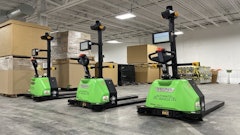Rockville, MD — May 15, 2003 — Waving the banner of open architecture, solution provider Manugistics this week rolled out the latest major release of its flagship supply chain management solution, touting the interoperability, flexibility, scalability and low total cost of ownership that it said results from the solution's grounding in open standards.
Manugistics 7.1 is built on J2EE for application development, application-to-application integration, portal connectivity and business process management, according to the provider, which said that 7.1 is Web-client architected and meets extreme scalability requirements.
The new version's key benefits for business users include improved execution capabilities designed to dynamically interact with strategic and operational planning processes and systems to help companies monitor operations in real time. Manugistics said that the increased visibility provided by 7.1 allows users to more quickly respond to unplanned network events to minimize their impact on business performance.
In addition, 7.1 provides predictive analytic capabilities that are designed to recognize repeating patterns of past business disruptions, allowing companies to modify and adapt their ongoing plans to prevent repeat occurrences of common business disruptions, Manugistics said.
The results, according to the provider, include plans that better reflect the realities and events occurring in the business, and execution which is more systematically driven by optimized business plans.
Commenting on this new capability, Everett Plante, senior vice president of engineering and technology solutions with Manugistics, said: "One strength of our solution has always been the ability to analyze a particular supply chain and determine the appropriate strategy for execution against that supply chain. Now we've begun to integrate the analytics and, in an automated fashion, use the information that comes out of the analytics to automatically adjust the planning solution to respond to variances in execution."
As an example, Plante cited a capability in 7.1 called demand classification, whereby the solution looks at demand historically and determines, for instance, whether the demand is seasonal or has a traditional lifecycle curve, and then determines which forecasting techniques would be most applicable to predict the forward demand on a particular item. By integrating this demand classification concept with the demand forecasting solution, the software can automatically adjust the forecasting algorithm to produce a more accurate forward-looking demand signal, Plante said.
Manugistics has begun applying that same concept to its solution's fulfillment and replenishment capabilities, although in those areas, because of the variance of execution, the company is looking at this more as adaptive analytics, that is, providing real-time visibility into the variance between plan and execution, and then suggesting the appropriate responses to adjust the algorithm, allowing the user to make that type of call.
Other capabilities that Manugistics is highlighting with the 7 series include real-time visibility and event management, providing supply chain transparency from purchase order through proof-of-delivery based on the use of a metadata engine to connect to and create user-configurable views and queries to Manugistics and non-Manugistics data. Additional pre-built and configurable exception rules with resolution paths further automate this real-time process, and an activity management function assigns a multi-step execution or activity sequence for planned orders and shipments so that exceptions can be detected and addressed.
By building version 7.1 on J2EE open standards, Manugistics said it is offering a solution that can leverage Web services and real-time application programming interfaces (APIs) to reduce integration costs and improve synchronization with heterogeneous systems. "Our goal is to allow people to plug-and-play services," Plante said, "to open up our architecture so that as clients put new capabilities into place, we can interoperate with those capabilities."
Manugistics is also emphasizing the flexibility and scalability that the 7.1 architecture affords. The suite, said the provider, is highly configurable at the user-interface, business-logic and data levels, which can decrease migration costs and minimize required business process changes, while the scalability of the solution helps to minimize hardware costs and enables real-time adaptive planning.
"We believe that one of the things that drives [return on investment] is a solution's ability to respond to business change," Plante said, "and one of the benefits of our architecture that we're now able to exploit is its responsiveness to business change." As an example, Plante said that the solution would allow a company to add new distribution center to its supply chain and incorporate the additional DC into its planning essentially immediately.
From a scalability perspective, Plante said the 7.1 solution is able to take very large supply chain problems, break it down into smaller problems in a managed environment, and then solve each individual problem on a separate computer, allowing the solution to address much larger challenges that was possible previously, such as store-level planning in the retail space.
"A lot of folks try to solve these larger problems by creating kluges and breaking problems into multiple instances and solving them in parallel," Plante said. "That's a very labor-intensive process that doesn't allow you to be flexible when your business changes."
Manugistics' approach also reduces the hardware investment necessary to solve these big problems, Plante asserted. He also emphasized that the ability to accelerate the planning cycle can allow companies to move planning from a weekly or monthly exercise to perhaps a daily exercise.















